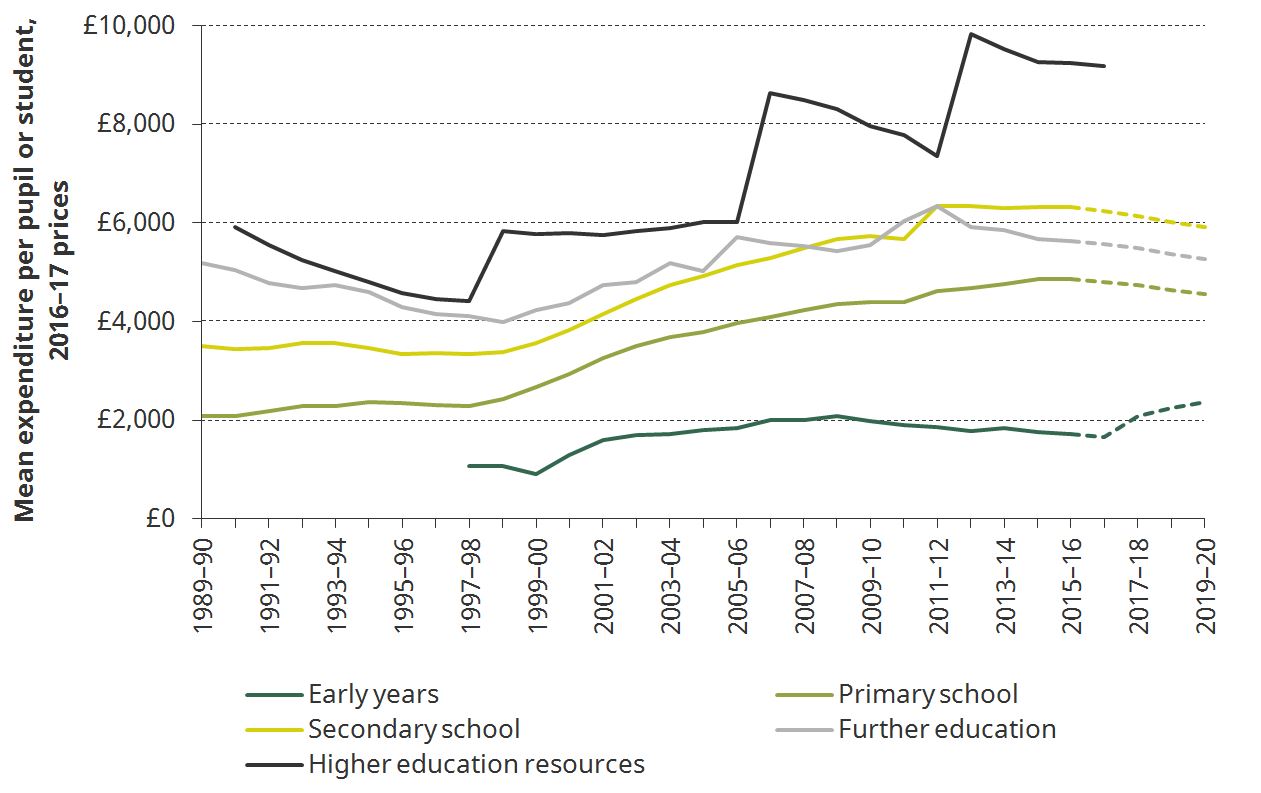
Education
Education
Education spending is the second-largest area of public service spending in the UK, representing about 4.5% of national income in 2015–16. In a recent report, we compared spending across stages of education over time.
Spending per pupil or student per year at different stages of education, actual and plans (2016–17 prices)
Source: Figure 6.1a, Long-run comparisons of spending per pupil across different stages of education, February 2017
Key findings:
- Government spending on education grew by around 1.7% per year in real terms over the 1980s and 1990s, before increasing sharply over the 2000s by more than 5% per year in real terms. With the exception of 16–18 education spending, most areas of education have been protected from cuts since 2010–11.
- Government spending on early years education was around £1,700 per child in pre-school in 2015–16, less than half the level of spending in primary schools.
- Primary and secondary school spending per pupil have almost doubled in real terms between 1997–98 and 2015–16, but spending per pupil was expected to fall by 6.5% in real terms between 2015–16 and 2019–20.
- Further education has been the only major area of education spending to see cuts since 2010 and spending is set to fall further between 2015–16 and 2019–20, leaving spending per student at a similar level in real terms to that 30 years previously.
- In 1990–91, spending per student in further education was nearly 50% higher than spending per student in secondary schools, but in 2015–16 it was 10% lower, at around £5,600 per student.
- Up-front government spending on undergraduate education was £9.7 billion for 2015–16 entrants, but the expected long-run cost is only £3.7 billion. The level of resources available per student starting university in 2015 was £28,000, over 50% higher in real terms than in 1990.
IFS election 2017 publications
Observations
Chris Belfield and Luke Sibieta, Comparison of parties’ plans for education spending on 16-18 year-olds in England, 1 June 2017
Chris Belfield and Luke Sibieta, A comparison of manifesto proposals on school spending in England, 26 May 2017
Sarah Cattan and Christine Farquharson, More hours, more children, and more spending: early years and childcare proposals from Labour and the Liberal Democrats, 17 May 2017
Chris Belfield, Jack Britton and Laura van der Erve, Labour’s Higher Education proposals will cost £8bn per year, although increase the deficit by more. Graduates who earn most in future would benefit most, 11 May 2017
Jack Britton and Luke Sibieta, Labour’s proposed boost to education spending, 10 May 2017
Lorraine Dearden and Christine Farquharson, Free school meals for all primary pupils: Projections from a pilot, 9 May 2017
Luke Sibieta, Election battleground in the playground?, 26 April 2017
Useful resources
IFS Briefing notes
Chris Belfield and Luke Sibieta, The short- and long-run impact of the national funding formula for schools in England, 22 March 2017
Chris Belfield, Claire Crawford and Luke Sibieta, Long-run comparisons of spending per pupil across different stages of education, 27 February 2017
IFS Green Budget analysis
Neil Amin-Smith, Jonathan Cribb and Luke Sibieta, Reform to apprenticeship funding in England, IFS Green Budget 2017
Observation
Chris Belfield and Luke Sibieta, A comparison of manifesto proposals on school spending in England, 26 May 2017
Chris Belfield, Jack Britton, Laura van der Erve, Labour’s Higher Education proposals will cost £8bn per year, although increase the deficit by more. Graduates who earn most in future would benefit most, 11 May 2017
Luke Sibieta, Can grammar schools improve social mobility?, 12 September 2016
Newspaper article
Paul Johnson, Extraordinary study proves richest children are in a class of their own, The Times, 17 April 2017




